US Stock Markets Developing Bullish Pattern
Stock-Markets / US Stock Markets Apr 26, 2008 - 02:49 PM GMTBy: Mike_Burk
The good news is: The market has been in a pattern of higher highs and higher lows for over a month now.
Short Term
The chart below covers the past 100 trading days showing the NASDAQ composite (OTC) in blue and an indicator showing the percentage of the last 3 trading days that the NASDAQ AD line (OTC ADL) was up in brown. Dashed vertical lines have been drawn on the 1st trading day of each month; the vertical line is red on the 1st trading day of the year. The indicator touches the top of the chart when there have been 3 consecutive up days and it touches the bottom of the screen when there have been 3 consecutive down days. OTC ADL (not shown) is a running total of NASDAQ declining issues subtracted from NASDAQ advancing issues.
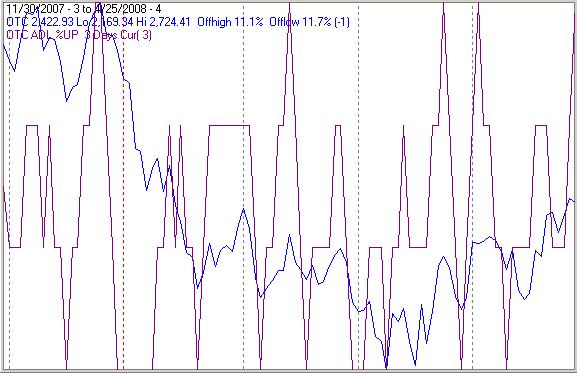
The indicator hit the top of the chart on Friday for the 4th time this year. Each of the other three occurrences have been followed by a short term decline.
Intermediate Term
The chart below covers the past 2 years showing the OTC in blue and the ratio of NASDAQ new highs to new highs + new lows (OTC HL Ratio = NH / (NH + NL)). Dashed horizontal lines have been drawn at 10% increment levels for the indicator, the line is solid at the 50% level (above which the number of new highs is greater than new lows). Most declines have been brief making the indicator recover quickly after dropping below the 50% level. The indicator has been below the 50% level for 6 months and turned downward last week.
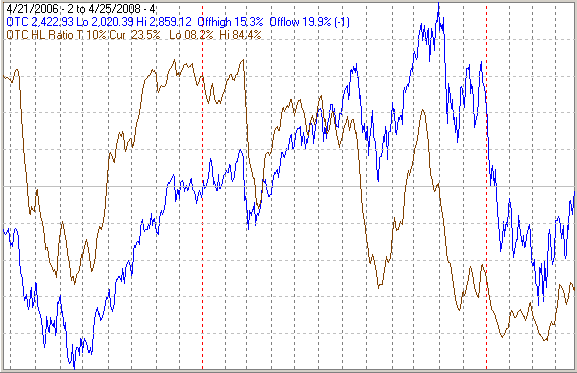
The next chart shows the index and indicator over the past 10 years. Dashed vertical lines have been drawn on the 1st trading day of each year.
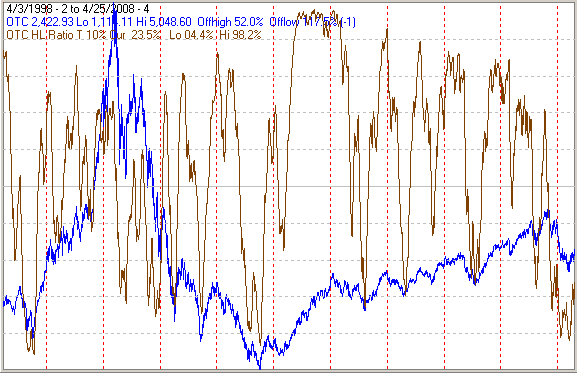
There were periods when the indicator spent several months below the 50% line in 2002, 2001 and 2000. The following charts show periods when the indicator spent several months below the 50% level in more detail.
The next chart shows a 9 month period at the 2002 bottom, the last time the indictor was below the 50% level for nearly 6 months.
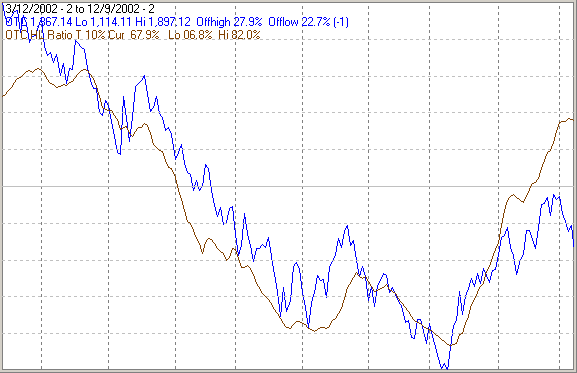
The next chart covers 1.5 years from late 1999 to early 2001.
The indicator spent most of the time from April 2000 to January 2001 under the 50% level, but popped above it for 2 brief periods.
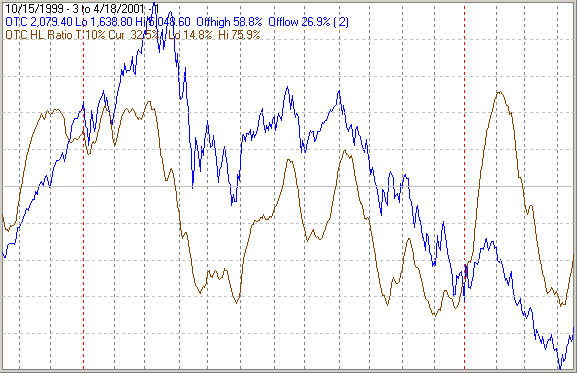
The next chart covers February 1994 to February 1995 when the indicator was below the 50% level for nearly 5 months, but never dropped below the 20% level.
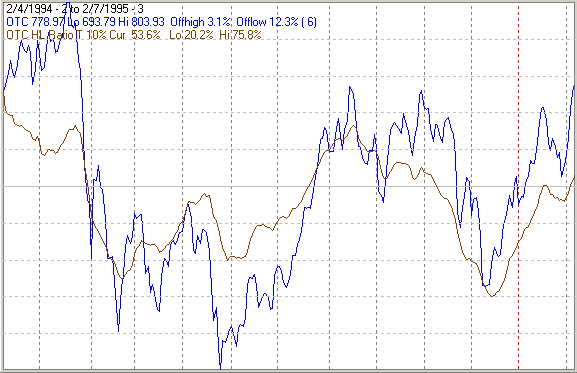
During the 1990 decline the indicator was below the 50% level for about 6 months, recovering quickly after it broke above the 30% level.
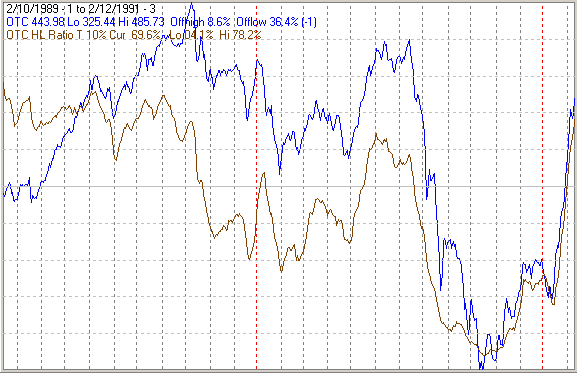
The next chart shows the 1987 crash where the indicator was below the 50% level for about 4 months.
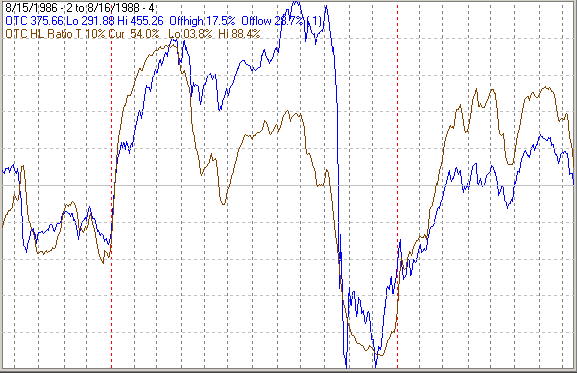
The next chart covers the period from early 1983 to early 1985. The indicator was under the 50% level for over 6 months in early 1984.
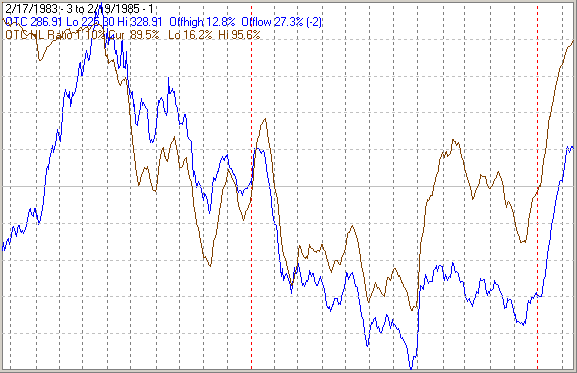
The next chart shows the period from late 1980 to late 1982. The indicator was below the 50% level for most of the time from mid 1981 to mid 1982.
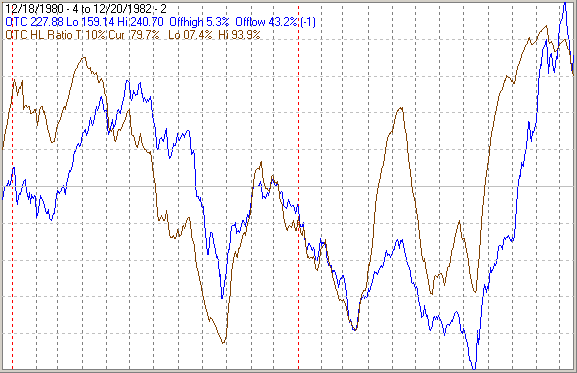
The current period has been one of the longest the indicator has been below the 50% and it has not started the rapid rise that would suggest this bear market is over.
Seasonality
Next week includes the last 3 trading days of April and the first 2 trading days of May during the 4th year of the Presidential Cycle.
The tables show the daily return on a percentage basis for the last 3 trading days of April and the first 2 trading days of May during the 4th year of the Presidential Cycle. OTC data covers the period from 1963 - 2007 and S&P 500 (SPX) data from 1928 - 2007. There are summaries for both the 4th year of the Presidential Cycle and all years combined.
By most measures the week has been modestly positive. In 1932 the SPX was down 10% for the week skewing the average return.
Report for the last 3 days of April and the first 2 days of May.
The number following the year represents its position in the presidential cycle.
The number following the daily return represents the day of the week;
1 = Monday, 2 = Tuesday etc.
| OTC Presidential Year 4 | ||||||
| Day3 | Day2 | Day1 | Day1 | Day2 | Totals | |
| 1964-4 | -0.03% 2 | 0.57% 3 | -0.49% 4 | -0.05% 5 | 0.85% 1 | 0.85% |
| 1968-4 | 1.87% 5 | 0.30% 1 | 0.30% 2 | 0.00% 3 | 0.60% 4 | 3.07% |
| 1972-4 | 0.06% 3 | 0.07% 4 | 0.24% 5 | -0.89% 1 | -0.63% 2 | -1.15% |
| 1976-4 | 0.36% 3 | 0.28% 4 | -0.52% 5 | -1.14% 1 | 0.21% 2 | -0.82% |
| 1980-4 | 0.45% 1 | 0.58% 2 | 0.46% 3 | -0.22% 4 | 0.41% 5 | 1.68% |
| 1984-4 | 0.83% 4 | 0.39% 5 | 0.22% 1 | 1.15% 2 | 1.09% 3 | 3.68% |
| Avg | 0.71% | 0.33% | 0.14% | -0.22% | 0.34% | 1.29% |
| 1988-4 | 0.22% 3 | 0.03% 4 | 0.12% 5 | 0.13% 1 | 0.66% 2 | 1.16% |
| 1992-4 | -1.17% 2 | 1.72% 3 | 1.53% 4 | -0.09% 5 | 0.93% 1 | 2.92% |
| 1996-4 | 0.23% 5 | 0.11% 1 | 0.19% 2 | 0.77% 3 | -1.78% 4 | -0.48% |
| 2000-4 | -2.19% 3 | 3.96% 4 | 2.30% 5 | 2.52% 1 | -4.36% 2 | 2.24% |
| 2004-4 | -2.12% 3 | -1.55% 4 | -1.97% 5 | 0.97% 1 | 0.61% 2 | -4.06% |
| Avg | -1.00% | 0.85% | 0.43% | 0.86% | -0.79% | 0.36% |
| OTC summary for Presidential Year 4 1964 - 2004 | ||||||
| Averages | -0.13% | 0.59% | 0.22% | 0.29% | -0.13% | 0.83% |
| % Winners | 64% | 91% | 73% | 45% | 73% | 64% |
| MDD 4/30/2004 5.53% -- 5/2/2000 4.36% -- 5/2/1996 1.78% | ||||||
| OTC summary for all years 1963 - 2007 | ||||||
| Averages | -0.02% | 0.11% | 0.31% | 0.27% | 0.20% | 0.87% |
| % Winners | 71% | 62% | 69% | 61% | 73% | 67% |
| MDD 4/30/2004 5.53% -- 4/29/1970 4.61% -- 5/4/1999 4.51% | ||||||
| SPX Presidential Year 4 | ||||||
| Day3 | Day2 | Day1 | Day1 | Day2 | Totals | |
| 1928-4 | 1.08% 5 | 0.36% 6 | 0.00% 1 | 0.15% 2 | 0.25% 3 | 1.84% |
| 1932-4 | -3.83% 4 | -3.32% 5 | 0.00% 6 | -1.54% 1 | -1.39% 2 | -10.08% |
| 1936-4 | -0.14% 2 | -2.94% 3 | 1.77% 4 | 0.73% 5 | -0.50% 6 | -1.09% |
| 1940-4 | 0.08% 6 | 0.25% 1 | 0.58% 2 | -1.31% 3 | 0.58% 4 | 0.18% |
| 1944-4 | 0.43% 4 | 0.51% 5 | 0.00% 6 | 0.76% 1 | -0.08% 2 | 1.61% |
| Avg | -0.48% | -1.03% | 0.47% | -0.24% | -0.23% | -1.51% |
| 1948-4 | 0.13% 3 | -0.32% 4 | -0.26% 5 | -0.26% 6 | 1.04% 1 | 0.33% |
| 1952-4 | -0.13% 1 | -0.25% 2 | -0.72% 3 | -0.64% 4 | 1.68% 5 | -0.07% |
| 1956-4 | 0.85% 4 | 1.05% 5 | 0.81% 1 | -0.45% 2 | 0.02% 3 | 2.28% |
| 1960-4 | 0.00% 3 | -0.87% 4 | -0.35% 5 | -0.44% 1 | 1.29% 2 | -0.37% |
| 1964-4 | 0.69% 2 | -0.25% 3 | -0.30% 4 | 0.89% 5 | 0.37% 1 | 1.41% |
| Avg | 0.31% | -0.13% | -0.16% | -0.18% | 0.88% | 0.72% |
| 1968-4 | 0.30% 5 | 0.26% 1 | 0.13% 2 | 0.39% 3 | 0.63% 4 | 1.71% |
| 1972-4 | -0.21% 3 | 0.15% 4 | 0.58% 5 | -0.91% 1 | -0.57% 2 | -0.97% |
| 1976-4 | 0.27% 3 | 0.00% 4 | -0.48% 5 | -0.71% 1 | 0.50% 2 | -0.43% |
| 1980-4 | 0.46% 1 | 0.21% 2 | 0.41% 3 | -0.78% 4 | 0.11% 5 | 0.40% |
| 1984-4 | 1.04% 4 | -0.26% 5 | 0.10% 1 | 1.02% 2 | 0.14% 3 | 2.04% |
| Avg | 0.37% | 0.07% | 0.15% | -0.20% | 0.16% | 0.55% |
| 1988-4 | -0.05% 3 | -0.45% 4 | -0.49% 5 | 0.09% 1 | 0.55% 2 | -0.35% |
| 1992-4 | 0.16% 2 | 0.71% 3 | 0.71% 4 | -0.58% 5 | 1.06% 1 | 2.06% |
| 1996-4 | 0.09% 5 | 0.11% 1 | 0.00% 2 | 0.06% 3 | -1.71% 4 | -1.45% |
| 2000-4 | -1.09% 3 | 0.27% 4 | -0.85% 5 | 1.09% 1 | -1.50% 2 | -2.08% |
| 2004-4 | -1.38% 3 | -0.76% 4 | -0.59% 5 | 0.92% 1 | 0.18% 2 | -1.63% |
| Avg | -0.45% | -0.03% | -0.24% | 0.32% | -0.28% | -0.69% |
| SPX summary for Presidential Year 4 1928 - 2004 | ||||||
| Averages | -0.06% | -0.28% | 0.05% | -0.08% | 0.13% | -0.23% |
| % Winners | 60% | 50% | 40% | 50% | 70% | 50% |
| MDD 5/3/1932 9.73% -- 4/29/1936 3.08% -- 4/30/2004 2.71% | ||||||
| SPX summary for all years 1928 - 2007 | ||||||
| Averages | -0.13% | -0.07% | 0.31% | 0.07% | 0.17% | 0.33% |
| % Winners | 51% | 49% | 61% | 54% | 71% | 65% |
| MDD 5/3/1932 9.73% -- 5/2/1930 7.10% -- 5/2/1934 5.09% | ||||||
May
On average the OTC has been up 56% of the time in May with an average gain of 0.4%. During the 4th year of the Presidential Cycle it has been up 64% of the time with an average loss of 0.1% attributable to the 14.1% loss in 2000. The best May ever for the OTC was 1997 when it was up 10.2%.
There are usually 21 trading days in a month. The charts below have been calculated by averaging the daily return of the 1st 11 trading days of the month and the last 10. A dashed vertical line has been drawn after the 1st trading day and at 5 trading day intervals after that. The vertical line is solid at the 11th trading day, the dividing point.
The 1st chart shows the OTC average for May for all years in blue and the 4th year of the Presidential Cycle in green.
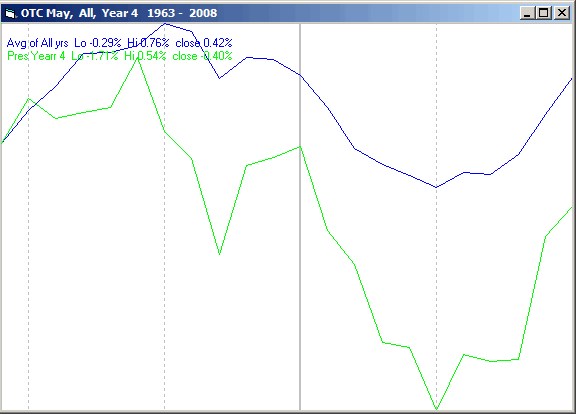
On average the SPX has also been up 56% of the time in May (since 1928) with an average loss of 0.2% (helped by a 22.1% loss in 1932 and a 22.9% loss in 1940). During the 4th year of the Presidential Cycle it has been up 70% of the time with an average loss of 1.4% (both 1932 and 1940 were 4th years in the Presidential Cycle). The best May ever for the SPX was 1990 when it rose 8.7%.
The chart below is similar to the one above except it shows SPX averages since 1928 and the SPX for all years is shown in red.
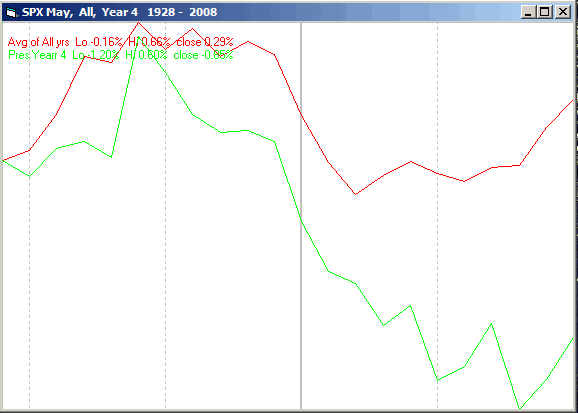
Conclusion
The market is a bit overbought and there is little strength in the breadth indicators, but there could be some seasonal strength showing up near the end of the week.
I expect the major indices to be higher on Friday May 2 than they were on Friday April 25
It is difficult to find insight into short term trading. For the past 6 months I have been getting frequent trading updates from Tom Malone. On the downside, he sends out about a dozen e-mail updates a day (way too many for me) on the upside, he is the best short term trader I have ever seen. If you are interested in the insights of a successful short term trader his e-mail address is: Tomandprisha@msn.com .
Last weeks negative forecast was a miss.
By Mike Burk
To subscribe to this report : http://alphaim.net/signup.html
Gordon Harms produces a Power Point for our local timing group. You can get a copy of that at: http://www.stockmarket-ta.com/ .
Disclaimer: Mike Burk is an employee and principal of Alpha Investment Management (Alpha) a registered investment advisor. Charts and figures presented herein are believed to be reliable but we cannot attest to their accuracy. Recent (last 10-15 yrs.) data has been supplied by CSI (csidata.com), FastTrack (fasttrack.net), Quotes Plus (qp2.com) and the Wall Street Journal (wsj.com). Historical data is from Barron's and ISI price books. The views expressed are provided for information purposes only and should not be construed in any way as investment advice. Furthermore, the opinions expressed may change without notice.
Mike Burk Archive |
© 2005-2022 http://www.MarketOracle.co.uk - The Market Oracle is a FREE Daily Financial Markets Analysis & Forecasting online publication.



